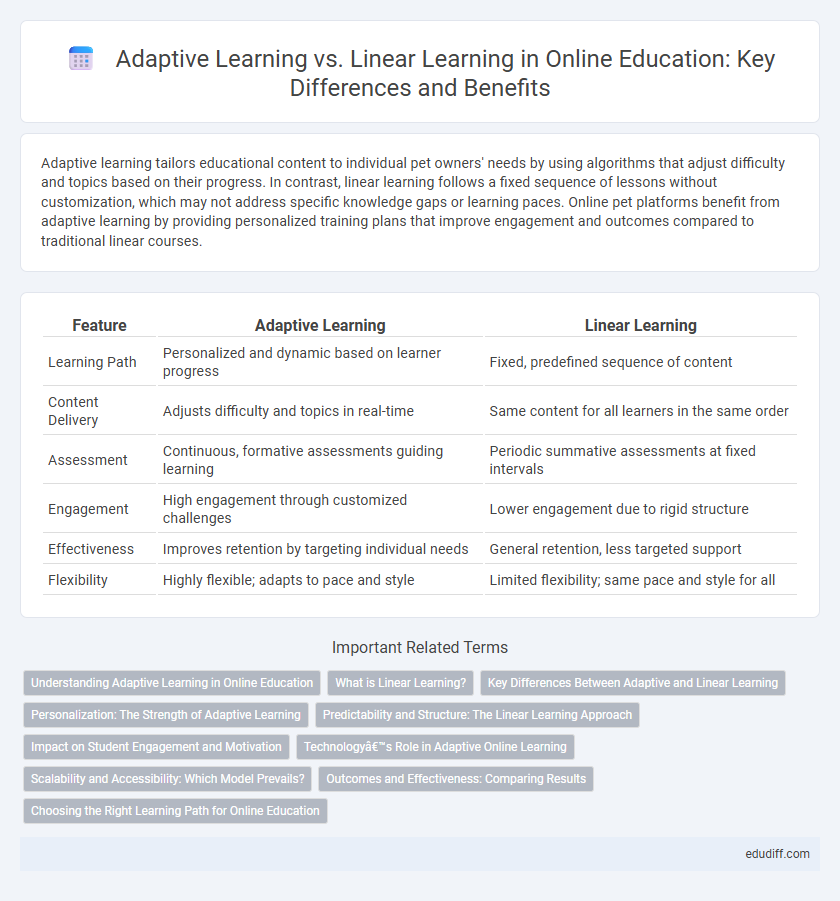Adaptive learning tailors educational content to individual pet owners' needs by using algorithms that adjust difficulty and topics based on their progress. In contrast, linear learning follows a fixed sequence of lessons without customization, which may not address specific knowledge gaps or learning paces. Online pet platforms benefit from adaptive learning by providing personalized training plans that improve engagement and outcomes compared to traditional linear courses.
Table of Comparison
| Feature | Adaptive Learning | Linear Learning |
|---|---|---|
| Learning Path | Personalized and dynamic based on learner progress | Fixed, predefined sequence of content |
| Content Delivery | Adjusts difficulty and topics in real-time | Same content for all learners in the same order |
| Assessment | Continuous, formative assessments guiding learning | Periodic summative assessments at fixed intervals |
| Engagement | High engagement through customized challenges | Lower engagement due to rigid structure |
| Effectiveness | Improves retention by targeting individual needs | General retention, less targeted support |
| Flexibility | Highly flexible; adapts to pace and style | Limited flexibility; same pace and style for all |
Understanding Adaptive Learning in Online Education
Adaptive learning in online education customizes content delivery based on individual learner performance, using data analytics and artificial intelligence to identify strengths and weaknesses. Unlike linear learning, which follows a fixed sequence, adaptive learning adjusts the pace and difficulty, enhancing engagement and knowledge retention. This personalized approach improves learning outcomes by addressing unique needs and promoting mastery of concepts efficiently.
What is Linear Learning?
Linear learning is a structured educational approach where content is presented in a fixed, sequential order, requiring learners to complete one module before progressing to the next. This method emphasizes consistency and mastery of foundational concepts but lacks flexibility to accommodate individual learning paces or styles. Linear learning is commonly used in traditional e-learning platforms and standardized training programs.
Key Differences Between Adaptive and Linear Learning
Adaptive learning utilizes real-time data and algorithms to customize educational content based on individual learner performance, while linear learning follows a predetermined, fixed sequence of lessons regardless of the student's progress. Adaptive systems improve engagement and knowledge retention by targeting specific weaknesses, whereas linear approaches emphasize consistency and standardization across learners. Key differences include adaptability to learner needs, pacing flexibility, and personalized feedback availability.
Personalization: The Strength of Adaptive Learning
Adaptive learning leverages real-time data and algorithms to tailor educational content to individual student needs, fostering a highly personalized learning experience. In contrast, linear learning follows a fixed progression that often fails to address individual strengths and weaknesses, limiting engagement and efficacy. The personalized approach of adaptive learning accelerates mastery by continuously adjusting difficulty levels and content based on learner performance and preferences.
Predictability and Structure: The Linear Learning Approach
Linear learning provides a predictable and structured pathway by following a fixed sequence of topics, ensuring learners progress through content in a specific order. This method supports clear expectations and standardized assessments, making it easier to measure progress against predetermined milestones. Predictability in linear learning enhances consistency, which benefits both instructors and learners seeking a systematic educational experience.
Impact on Student Engagement and Motivation
Adaptive learning tailors educational content to individual student needs using data-driven algorithms, significantly boosting engagement and motivation by providing personalized challenges that match skill levels. In contrast, linear learning follows a fixed curriculum path, often leading to disengagement as students encounter either overly difficult material or boredom from repetitive content. Studies show adaptive learning increases persistence and enthusiasm by continuously adjusting learning paths, whereas linear approaches may hinder student motivation due to lack of flexibility and responsiveness.
Technology’s Role in Adaptive Online Learning
Technology in adaptive online learning utilizes real-time data analytics and artificial intelligence to tailor educational content to individual learner's needs, enhancing engagement and outcomes. Unlike linear learning, which presents material in a fixed sequence, adaptive systems dynamically adjust difficulty and resources based on user performance and preferences. This technological integration enables personalized pacing, immediate feedback, and a more efficient learning process that supports diverse learning styles and abilities.
Scalability and Accessibility: Which Model Prevails?
Adaptive learning platforms utilize AI-driven algorithms to personalize content, enhancing scalability by efficiently addressing diverse learner needs without requiring proportional increases in instructional resources. Linear learning models, though simpler to implement, often struggle with scalability as fixed content delivery fails to accommodate varying learner paces and styles, limiting accessibility for larger and diverse student populations. The adaptive approach prevails in creating accessible, scalable online education environments by dynamically adjusting to individual learner progress and engagement levels.
Outcomes and Effectiveness: Comparing Results
Adaptive learning systems customize content based on individual performance, leading to higher retention rates and improved problem-solving skills compared to linear learning methods. Studies show adaptive learning increases course completion rates by up to 20% and accelerates mastery of complex subjects. Linear learning, while structured, often results in lower engagement and less personalized feedback, impacting overall effectiveness and learner outcomes.
Choosing the Right Learning Path for Online Education
Adaptive learning tailors online education by using algorithms to customize content based on individual student performance, promoting efficient knowledge absorption and retention. Linear learning follows a fixed sequence, offering a structured path suitable for learners who benefit from predictable progression and clear milestones. Selecting the right learning path depends on factors like learner autonomy, subject complexity, and the need for personalized feedback in online environments.
Adaptive learning vs Linear learning Infographic

 edudiff.com
edudiff.com